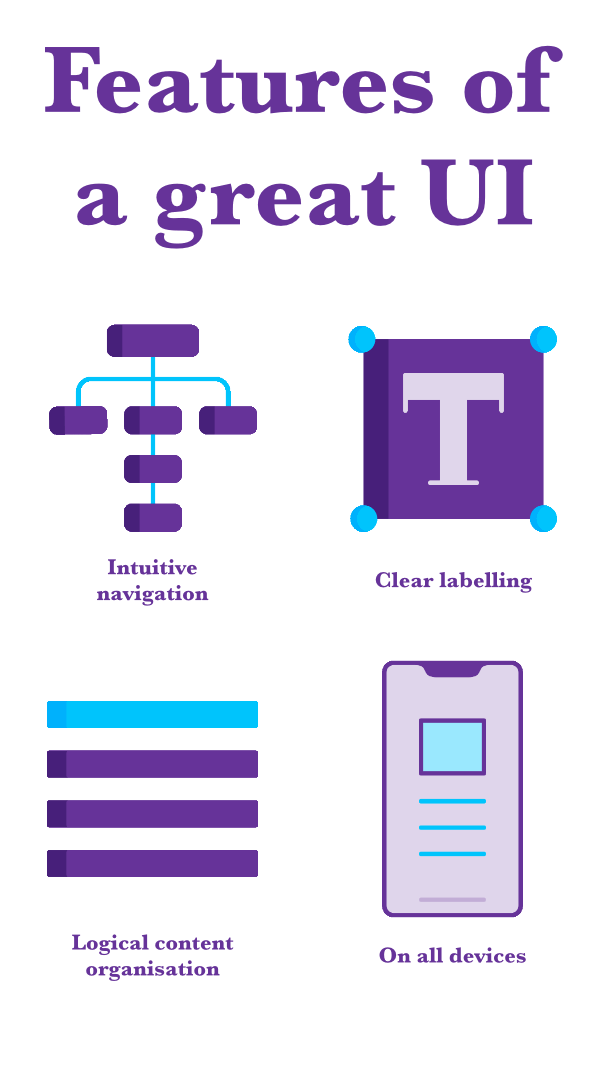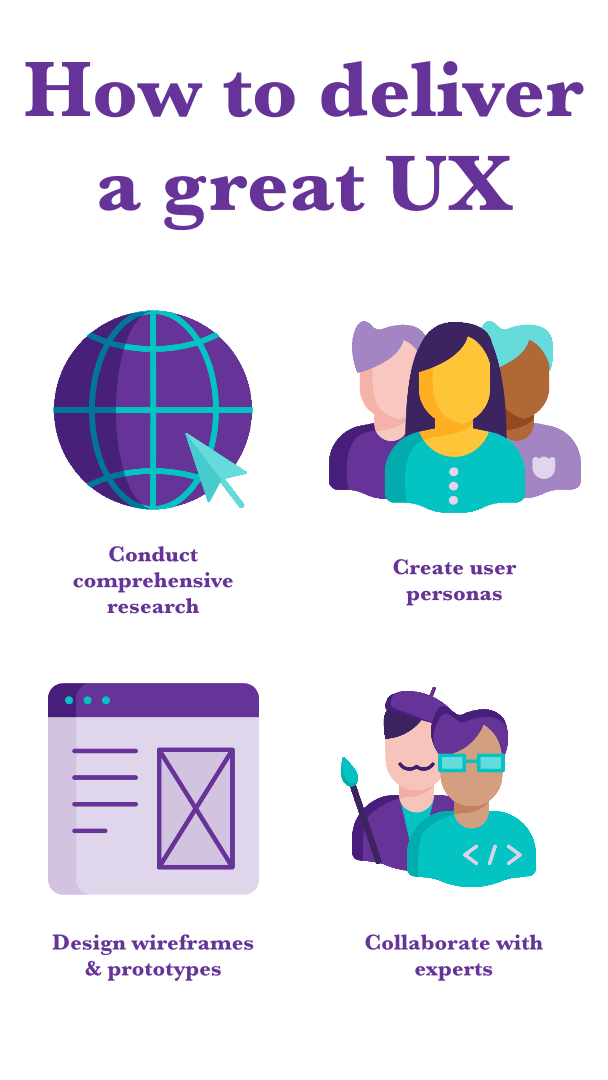As you’re reading this article, you’ve likely come across the terms UI (user interface) and UX (User Experience). These are often used interchangeably in the website design enclave. However, even though UI and UX and their functions are closely related, they’re not the same. Acknowledging the difference between the user interface and user experience is critical for developing a best-practice website that attracts the maximum amount of search traffic and provides the optimal experience for human visitors. It’s also useful to understand the differences if you’re thinking of hiring a UI or UX designer, so you can get the right skillset for your needs. You may choose to read on or listen to the audio.
Table of Contents
User Interface (UI): Features, tips, and tricks

The user interface comprises a website’s visual elements, including menus, toggles, icons, screens, buttons, options, forms, and other interactive factors. The term refers to the overall look and feel of a website and how human users interact with it. Incidentally, UI also applies to apps and software.
Good UI is crucial for building a great user experience, and this is likely why so many people use the terms interchangeably. However, UX encompasses so much more than just UI.
A lot goes into developing a website with a good UI, however, here are a few significant UI elements that contribute to flawless user interaction. By focusing on these key aspects, you can create a website that leaves a positive impression and receives appreciation for its user-friendly interface.
Intuitive navigation
Navigation features are the central elements of a website that impact the user experience. Make a website’s navigation system user-friendly so users can easily find their way through the components of the website.
Create an organised and smooth navigation menu that’s easy for users to locate, understand, and use. Make their experience seamless and intuitive so they can find their desired information without getting lost and frustrated.
Clear labelling
The language you use for labelling things like menus, buttons, and links, needs to be clear and concise to make your website easy for users to understand.
This step is especially important for users unfamiliar with the terms used on the website.
It’s also important to use colours and fonts that make it easy for visitors to read labels. If you want to take that part of your UI to the next level, you can also choose colours that make it easy for users to find the most used parts of the website. As an example, if your users frequently need to log into your website, choosing button colours that stand out, can make it much easier for user to quickly and easily find the login button every time.
As one specific suggestion, never use red and green together in a design if users need to be able to distinguish between the colours in order to use your site. E.g. Don’t put green text on a red button. The reason is, roughly 5-9% of people globally are red-green colour blind and they won’t be able to distinguish between elements with those colours.
Logical content organisation — on all devices
Proper content structuring is a crucial aspect of user interface design. Ensuring your website’s content is thoughtfully organised can significantly enhance the user experience. Grouping related content, using clear and informative headings, and establishing a comprehensible hierarchy helps guide users through your site’s content.
A well-structured content layout can ease the cognitive load on users by clearly indicating the connections and relevance among different pieces of content, thereby improving comprehension.
Investing in a well-crafted UI not only boosts the aesthetic appeal of your website, but also facilitates a smoother interaction for users.
User Experience (UX): Principles, Tips, and Best Practices

Once users have become familiar with the layout of your website, understanding the placement of various elements, controls, buttons, icons, and navigational tools, they then delve deeper into their journey on your site. However, is understanding the layout enough? Does the entirety of the user’s journey and their experience not hold equal, if not more, importance?
That’s where UX, or user experience, comes into play. UX goes beyond useability to encompass every aspect of the experience someone has when navigating your website. It addresses the ease of use, yes, but it also includes users’ reactions, emotional responses, and overall satisfaction derived from their interaction with your site.
If that sounds a little nebulous, don’t worry. There’s a huge range of UX design challenges you might face when building or revitalising your website. But there are some simple strategies that can help you overcome any UX challenge.
Comprehensive research
Comprehensive research is crucial in understanding your users’ needs, behaviors, goals, and challenges. Doing lots of research will help you understand your users’ specific requirements (especially what they want to achieve on your site), their pain points, areas of confusion, and how you can facilitate a more user-friendly experience.
Once you know what your users need, then you can start creating a solution that delivers a great experience for them.
Creating user personas
Comprehensive research may be a necessity in the land of UX, but it also results in a lot of data to deal with. One way to deal with all that information and make it manageable is to turn it into user personas. These are hypothetical characters created to reflect your website’s target users. This strategy aids in tailoring your site’s design, functionality, and content to the preferences and needs of your audience.
Develop wireframes and prototypes
Once you’ve come up with some ideas you think will help provide a great experience for your user personas, it’s time to plan out your design using wireframes and prototypes. This essential stage allows UI and UX designers to experiment with different design ideas, identify potential usability issues, and refine the design to best suit the target audience’s needs. Wireframes provide a basic, low-fidelity representation of your website’s structure and layout, while prototypes offer a more detailed and interactive version for testing the user experience.
To put it simply — it’s much cheaper to make changes to a wireframe or even a prototype than it is to build a whole website and then decide you need to change a foundational ingredient.
Collaborate with UI and UX designers and developers
If you’re having trouble developing a website UX to be proud of, it’s always useful to team up with designers and developers to help generate unique ideas for your website. Each will have different approaches to UX, and melding the two together can help you come up with unique solutions.
Impact of UI and UX on websites and user satisfaction
UI and UX designs play a crucial role in determining the performance and success of digital services. Here’s how they influence various aspects of a website.

Conversion rates
Effective UI and UX designs can nudge users towards taking your desired actions, whether that’s making a purchase or filling out a form. An intuitive, glitch-free user journey can also result in positive user feedback, lower bounce rates, increased user engagement, and ultimately, higher conversion rates.
Brand reputation
The performance and responsiveness of a website directly reflect on the brand’s reputation. A well-crafted UI and UX design can help distinguish your business from that of your competitors, boosting your brand’s image.
Customer satisfaction
Creating a user-friendly, enjoyable website directly contributes to customer satisfaction. Just think about your own experiences with websites that don’t work properly or are clunky. How did they make you feel? Were you annoyed? Did you recommend the brand to your friends? High satisfaction levels correlate with improved user experience, conversion rates, and referrals.
Cost savings
Investing in a well-designed user interface and a fantastic user experience upfront can result in substantial cost savings down the line. It helps reduce the need for frequent ‘tweaks’ and expensive redesigns by addressing potential issues during the initial stages of website development.
Innovation
Innovative UI and UX can drive your website forward, unlocking new business opportunities and improving digital products or services. Through user research and testing of creative solutions, designers can identify areas for enhancement, making their websites stand out and resonate with users.
The power of UI and UX in shaping user satisfaction
The influence of UI and UX design on user satisfaction is profound. A meticulously crafted user interface and experience can bolster your website’s traffic, boost conversions, enhance customer retention, and fortify your brand reputation. Conversely, if your website fails to meet users’ needs, it can result in frustration and disappointment.
For websites to truly flourish, website owners must assign equal importance to both UI and UX. As such, incorporating in-house UI and UX design skills or external UI and UX design services should be seen as a critical component of any digital strategy.
